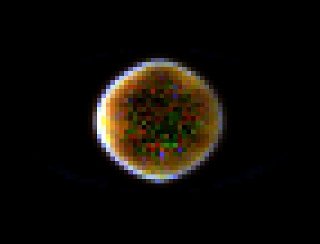Gamma-ray Earth: This pixelated image depicts our own planet, Earth, as seen in 35 MeV gamma rays. This gives a different view of the Earth than is obtainable using visible light, which is composed of approximately 2 eV photons. The Earth's gamma-ray glow is indeed very faint, and this image was constructed by combining data from seven years of exposure during the life of the Compton Gamma Ray Observatory, operating in Earth orbit from 1991 to 2000. Brightest near the edge and faint near the center, the picture indicates that the gamma rays are coming from high in Earth's atmosphere. The gamma rays are produced as the atmosphere interacts with high energy cosmic rays from space, blocking the harmful radiation from reaching the surface. Astronomers need to measure Earth's gamma-ray glow, as it can interfere with observations of cosmic gamma-ray sources like pulsars, supernova remnants, and distant active galaxies powered by supermassive black holes.
Credit: Dirk Petry (GLAST Science Support Center), EUD, EGRET, NASA)
We’ve known about gamma-ray bursts from space since 1967, from data collected by the Vela military satellites. Vela’s mission was to look for nuclear explosions in the atmosphere or in space from behind the Moon. Scientists were aware of a high energy radiation background, but Vela was looking for sudden bursts of such radiation that might indicate that a nuclear bomb had been detonated.
I have witnessed almost all of the history of this science story. By the time I came to Santa Cruz, in 1983, it was only 10 years after their discovery. When I joined the field, people like Stan Woosley and Stirling Colgate were the leading experts on the hypothetical sources of gamma-ray bursts. We thought they were in the Galaxy, and they were probably related to neutron stars. This is quite a long time ago. In the meantime we’ve learned they are of cosmological origin and we understand now that the long duration bursts are related to supernovae, albeit a special sub-class.


